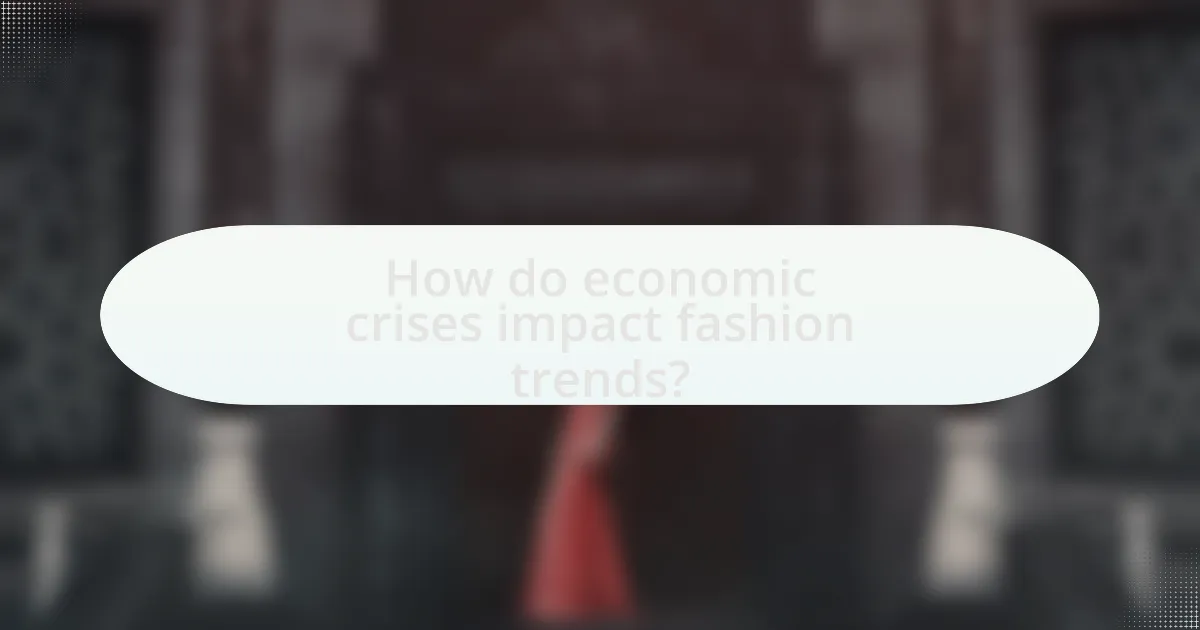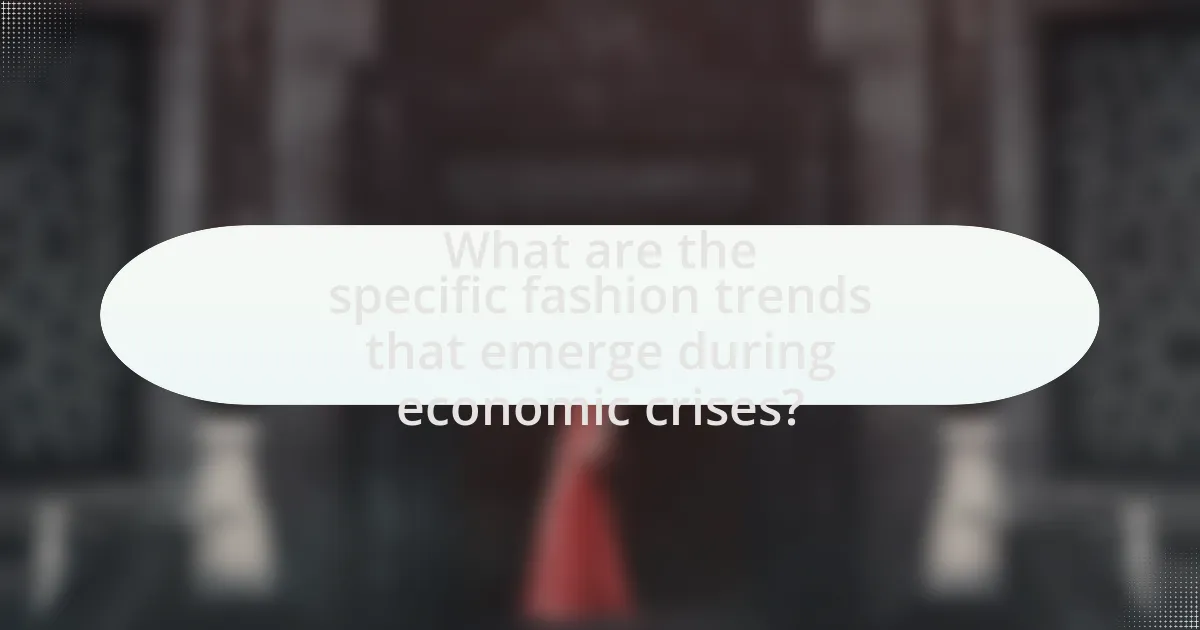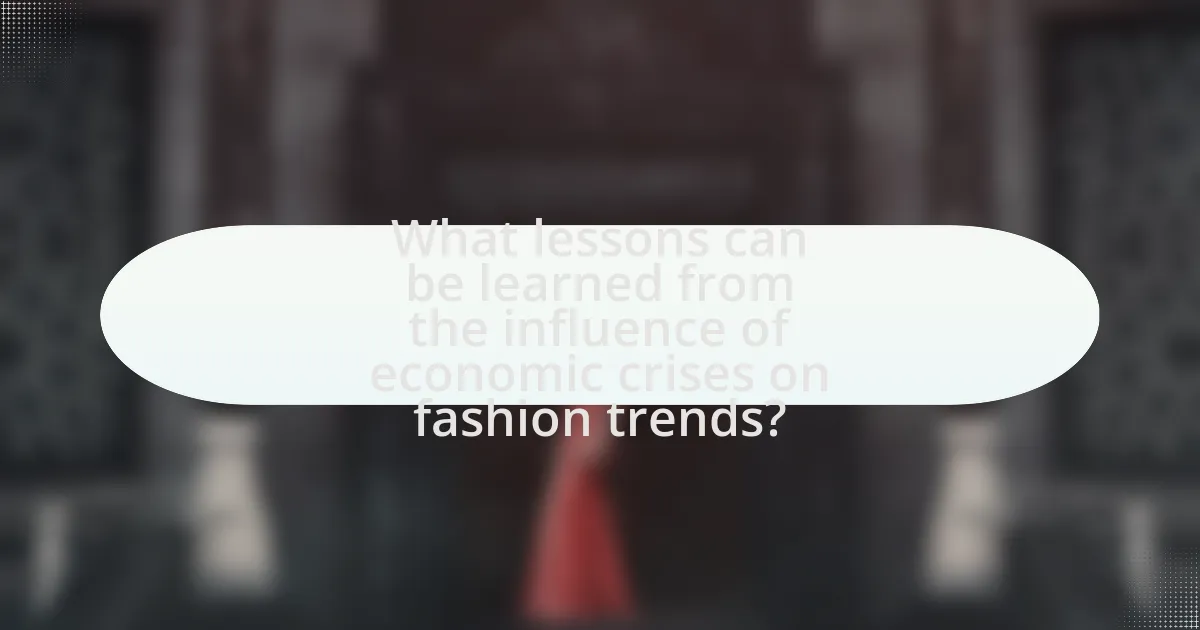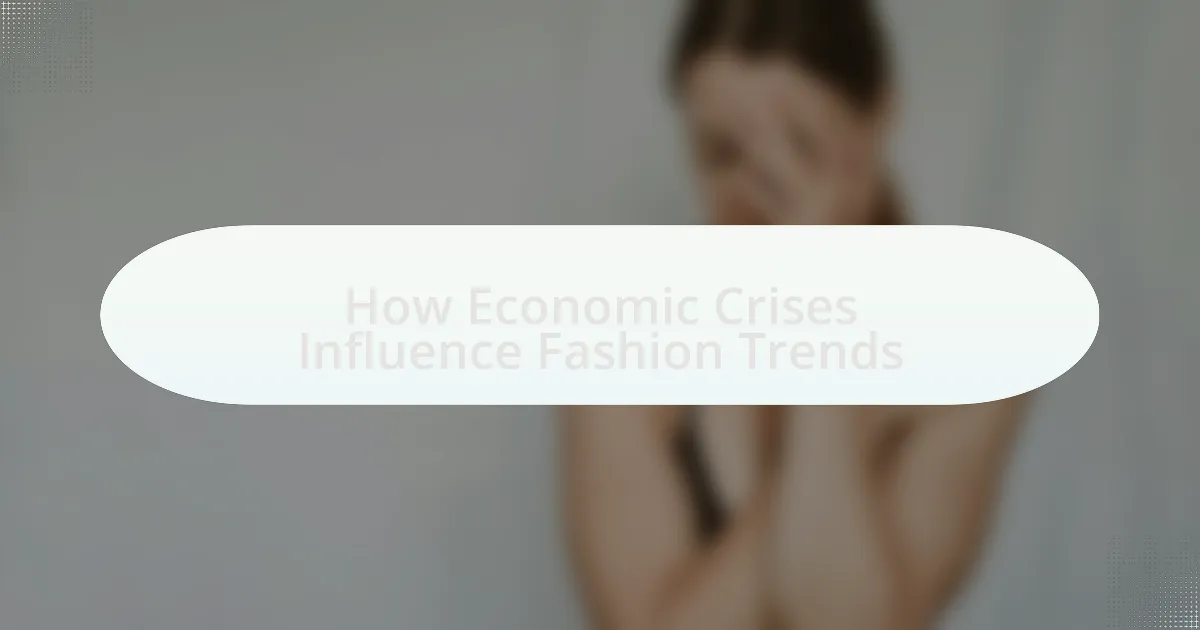The article examines how economic crises influence fashion trends, highlighting the shift in consumer behavior towards affordability and practicality during financial downturns. It discusses historical examples, such as the Great Depression and the 2008 financial crisis, illustrating how these events led to increased demand for budget-friendly brands, thrift shopping, and sustainable fashion. The article also explores the psychological impact of economic challenges on consumer choices, the adaptation strategies employed by fashion brands, and the emergence of specific trends like minimalism and second-hand clothing. Additionally, it provides practical tips for consumers on maintaining style on a budget while making sustainable fashion choices.

How do economic crises impact fashion trends?
Economic crises significantly impact fashion trends by shifting consumer behavior towards affordability and practicality. During economic downturns, consumers often prioritize essential purchases over luxury items, leading to a rise in demand for budget-friendly brands and second-hand clothing. For instance, the 2008 financial crisis saw a notable increase in thrift shopping and the popularity of fast fashion retailers, as consumers sought lower-cost alternatives. Additionally, economic uncertainty can drive trends towards minimalism and sustainability, as individuals become more conscious of their spending and environmental impact. This shift is evidenced by the growing popularity of sustainable fashion brands during recent economic challenges, reflecting a broader societal change in values influenced by financial constraints.
What are the historical examples of economic crises affecting fashion?
The Great Depression of the 1930s significantly affected fashion, leading to a shift towards more practical and affordable clothing as consumers faced economic hardship. During this period, luxury fashion declined, and brands adapted by offering simpler designs and lower-priced items to cater to the changing consumer needs. Another example is the 2008 financial crisis, which resulted in a decline in luxury goods sales, prompting high-end brands to rethink their marketing strategies and focus on more accessible price points. These economic downturns illustrate how financial crises can reshape fashion trends by influencing consumer behavior and brand strategies.
How did the Great Depression influence fashion choices?
The Great Depression significantly influenced fashion choices by promoting practicality and affordability over extravagance. During this period, economic hardship led consumers to prioritize durable and versatile clothing, resulting in simpler designs and the use of less expensive materials. For instance, the popularity of the “make-do and mend” philosophy encouraged individuals to repair and repurpose existing garments rather than purchase new ones. Additionally, fashion trends shifted towards more conservative styles, as seen in the rise of the “sack dress,” which emphasized comfort and ease of wear. This shift reflected the broader societal need for economic resilience and adaptability in the face of financial uncertainty.
What changes occurred in fashion during the 2008 financial crisis?
During the 2008 financial crisis, fashion experienced a significant shift towards affordability and practicality. Consumers prioritized budget-friendly options, leading to a rise in fast fashion brands that offered trendy clothing at lower prices. This shift was evidenced by the increased sales of retailers like H&M and Zara, which capitalized on the demand for stylish yet inexpensive apparel. Additionally, there was a notable decline in luxury fashion sales, with high-end brands reporting substantial drops in revenue as consumers cut back on discretionary spending. The crisis also prompted a focus on sustainable fashion, as economic constraints led consumers to seek longer-lasting, versatile pieces rather than disposable trends.
Why do consumers change their fashion preferences during economic downturns?
Consumers change their fashion preferences during economic downturns primarily due to a shift in spending behavior driven by financial constraints. During these periods, individuals often prioritize essential items over luxury goods, leading to a preference for more affordable, practical, and versatile clothing options. Research indicates that in times of economic hardship, such as the 2008 financial crisis, consumers gravitated towards discount retailers and second-hand shopping, reflecting a significant change in purchasing habits. This trend is supported by data showing that sales at thrift stores and discount fashion brands surged during economic downturns, highlighting the impact of financial uncertainty on consumer choices in fashion.
How does consumer spending behavior shift in response to economic challenges?
Consumer spending behavior typically shifts towards more cautious and value-oriented choices during economic challenges. When faced with economic downturns, consumers often prioritize essential goods over luxury items, leading to increased demand for budget-friendly products and discount retailers. For instance, during the 2008 financial crisis, data showed that sales of discount retailers like Dollar General surged, while high-end brands experienced a decline in sales. This trend reflects a broader pattern where consumers adjust their spending habits to maintain financial stability, often opting for necessities and seeking out sales or promotions to stretch their budgets.
What role does psychological impact play in fashion choices during crises?
Psychological impact significantly influences fashion choices during crises by altering consumer behavior and emotional responses. During economic downturns, individuals often seek comfort and familiarity in their clothing, leading to a preference for practical and affordable fashion. Research indicates that in times of uncertainty, such as the 2008 financial crisis, consumers gravitated towards brands that offered a sense of security and reliability, reflecting their psychological need for stability. Additionally, the desire for self-expression can manifest in fashion as a coping mechanism, where individuals use clothing to assert identity and resilience amidst adversity. This duality of seeking comfort while also expressing individuality underscores the complex relationship between psychological states and fashion choices during crises.
What are the broader societal effects of economic crises on fashion trends?
Economic crises significantly alter fashion trends by shifting consumer priorities towards affordability and practicality. During economic downturns, individuals often prioritize essential purchases over luxury items, leading to a rise in demand for budget-friendly clothing and a decline in high-end fashion sales. For instance, the 2008 financial crisis saw a notable increase in thrift shopping and the popularity of fast fashion brands, as consumers sought to maintain style without overspending. Additionally, economic hardships can foster a cultural shift towards sustainability, prompting consumers to favor second-hand clothing and eco-friendly brands, as seen in the growing popularity of vintage fashion during recent economic uncertainties. These trends reflect broader societal changes, where economic pressures influence not only purchasing behavior but also the values associated with fashion, emphasizing practicality and sustainability over extravagance.
How do economic downturns affect fashion industry employment and production?
Economic downturns significantly reduce employment and production in the fashion industry. During such periods, consumer spending declines, leading to decreased demand for clothing and accessories. As a result, companies often implement layoffs and hiring freezes to cut costs, which directly impacts employment levels. For instance, the 2008 financial crisis saw major fashion retailers like Gap and J.C. Penney reduce their workforce by thousands. Additionally, production is affected as brands may scale back their manufacturing operations or shift to cheaper materials and labor to maintain profitability. This trend was evident during the COVID-19 pandemic, where many fashion brands reported production halts and significant job losses, with estimates suggesting over 24 million jobs were lost in the global fashion supply chain.
What influence do economic crises have on sustainable fashion movements?
Economic crises significantly accelerate the adoption of sustainable fashion movements as consumers become more conscious of their spending and environmental impact. During economic downturns, individuals often prioritize value and longevity over fast fashion, leading to increased demand for sustainable and ethically produced clothing. For instance, a report by McKinsey & Company in 2020 indicated that 67% of consumers were more likely to buy from brands that demonstrate sustainability during the COVID-19 pandemic. This shift reflects a broader trend where economic challenges prompt consumers to seek out brands that align with their values, thereby fostering a more sustainable fashion landscape.
How do fashion brands adapt to economic crises?
Fashion brands adapt to economic crises by implementing cost-cutting measures, diversifying product lines, and enhancing digital presence. During economic downturns, brands often reduce production costs by streamlining operations and sourcing materials more efficiently. For example, in the 2008 financial crisis, many brands shifted to more affordable collections to cater to budget-conscious consumers. Additionally, brands expand their offerings to include lower-priced items or collaborations that appeal to a wider audience, as seen with luxury brands launching diffusion lines. Furthermore, enhancing digital marketing and e-commerce capabilities allows brands to reach consumers directly, which became crucial during the COVID-19 pandemic when physical retail was severely impacted. These strategies demonstrate how fashion brands respond to economic challenges while maintaining relevance and profitability.
What strategies do brands employ to remain relevant during downturns?
Brands employ several strategies to remain relevant during downturns, including adjusting pricing strategies, enhancing customer engagement, and focusing on sustainability. During economic downturns, brands often implement promotional pricing or discounts to attract cost-conscious consumers, as evidenced by a 2020 McKinsey report indicating that 75% of consumers are more price-sensitive during economic crises. Additionally, brands increase customer engagement through personalized marketing and community-building initiatives, which can foster loyalty and maintain relevance. Furthermore, a focus on sustainability resonates with consumers, as a Nielsen study found that 66% of global consumers are willing to pay more for sustainable brands, making this a crucial strategy during challenging economic times.
How do brands shift their marketing approaches in response to economic conditions?
Brands shift their marketing approaches in response to economic conditions by adapting their messaging, pricing strategies, and product offerings to align with consumer sentiment and spending behavior. During economic downturns, brands often emphasize value and affordability, promoting discounts and budget-friendly options to attract cost-conscious consumers. For instance, during the 2008 financial crisis, many fashion brands introduced lower-priced lines and focused on essential items rather than luxury goods, reflecting a shift in consumer priorities. Additionally, brands may increase their digital marketing efforts to reach consumers who are spending more time online, as seen in the rise of e-commerce during economic challenges. This adaptability allows brands to maintain relevance and sustain sales despite fluctuating economic circumstances.

What are the specific fashion trends that emerge during economic crises?
During economic crises, specific fashion trends that emerge include a shift towards minimalism, increased demand for second-hand clothing, and a focus on practicality and durability. Historical evidence shows that during the Great Depression, for instance, consumers gravitated towards simpler styles and repurposed garments, reflecting a need for affordability and resourcefulness. Additionally, the 2008 financial crisis saw a rise in thrift shopping and sustainable fashion, as individuals sought to save money while being environmentally conscious. These trends highlight how economic downturns influence consumer behavior towards more pragmatic and cost-effective fashion choices.
How do economic crises influence the popularity of certain styles?
Economic crises significantly influence the popularity of certain styles by shifting consumer preferences towards more practical, affordable, and durable fashion choices. During economic downturns, individuals often prioritize value over luxury, leading to increased demand for minimalist and utilitarian designs. For instance, the 2008 financial crisis saw a rise in thrift shopping and the popularity of brands that offered budget-friendly options, as consumers sought to stretch their spending. This trend is supported by data from the Fashion Institute of Technology, which noted that economic hardships typically result in a decline in high-end fashion sales while boosting the appeal of casual and functional attire.
What types of clothing become more popular during economic downturns?
During economic downturns, types of clothing that become more popular include affordable basics, casual wear, and second-hand or thrifted items. This shift occurs as consumers prioritize budget-friendly options and practicality over luxury or high-fashion items. Historical data from the 2008 financial crisis indicates a significant increase in sales of discount retailers and thrift stores, as consumers sought to stretch their budgets while still maintaining a sense of style.
How do color palettes and materials change in response to economic conditions?
Color palettes and materials shift in response to economic conditions by reflecting consumer sentiment and purchasing power. During economic downturns, muted colors and cost-effective materials become prevalent as brands aim to appeal to budget-conscious consumers. For instance, the 2008 financial crisis saw a rise in the use of darker, more subdued colors in fashion collections, as designers adapted to the reduced spending power of their clientele. Conversely, in periods of economic growth, vibrant colors and luxurious materials are favored, as consumers are more willing to invest in high-quality, statement pieces. This trend was evident in the post-recession recovery phase, where bold colors and innovative fabrics re-emerged in fashion shows, signaling renewed consumer confidence and spending.
What role does thrift culture play during economic crises?
Thrift culture plays a significant role during economic crises by promoting frugality and resourcefulness among consumers. During times of financial hardship, individuals often turn to thrift shopping as a means to save money while still acquiring necessary clothing and goods. For instance, during the 2008 financial crisis, thrift store sales surged by 20% as people sought affordable alternatives to traditional retail. This shift not only reflects changing consumer behavior but also influences fashion trends, as thrifted items become more popular and mainstream, leading to a rise in vintage and second-hand fashion.
How does the rise of thrift shopping affect mainstream fashion trends?
The rise of thrift shopping significantly influences mainstream fashion trends by promoting sustainability and unique styles. As consumers increasingly seek affordable and eco-friendly options, brands respond by incorporating vintage aesthetics and sustainable practices into their collections. For instance, a 2021 survey by ThredUp revealed that 70% of consumers are more likely to shop secondhand due to environmental concerns, prompting major retailers to launch thrift-inspired lines. This shift not only diversifies fashion offerings but also encourages a cultural acceptance of pre-owned clothing, reshaping consumer perceptions and driving trends towards individuality and sustainability.
What impact does second-hand clothing have on consumer behavior during crises?
Second-hand clothing significantly influences consumer behavior during crises by increasing demand for affordable fashion alternatives. Economic downturns often lead consumers to prioritize cost-saving measures, resulting in a shift towards thrift shopping and second-hand purchases. For instance, during the 2008 financial crisis, sales of second-hand clothing surged by 20% as consumers sought budget-friendly options. This trend reflects a broader behavioral change where individuals become more value-conscious and environmentally aware, opting for sustainable choices that second-hand clothing provides.
How do fashion designers respond to economic challenges?
Fashion designers respond to economic challenges by adapting their collections to align with consumer spending habits and preferences. During economic downturns, designers often shift towards more affordable materials and streamline production processes to reduce costs. For instance, in the 2008 financial crisis, many designers introduced lower-priced lines or collaborated with mass-market retailers to maintain sales. Additionally, they may focus on creating versatile pieces that encourage consumers to invest in fewer, high-quality items rather than fast fashion. This strategic pivot not only addresses immediate economic pressures but also reflects a growing consumer demand for sustainability and value, as evidenced by the rise in popularity of capsule wardrobes during economic hardships.
What innovative designs emerge from economic necessity?
Innovative designs that emerge from economic necessity often include functional, cost-effective, and sustainable fashion solutions. For example, during the Great Depression, clothing was repurposed and mended to extend its life, leading to the popularity of thrift and upcycling practices. Similarly, the rise of fast fashion in the early 2000s was a response to economic demands for affordable clothing, resulting in designs that prioritize low production costs and quick turnaround times. These trends demonstrate how economic constraints can drive creativity and adaptability in fashion design, leading to practical solutions that meet consumer needs while addressing financial limitations.
How do designers balance creativity and affordability during crises?
Designers balance creativity and affordability during crises by prioritizing resourcefulness and innovation in their design processes. During economic downturns, designers often utilize cost-effective materials and streamline production methods to reduce expenses while maintaining aesthetic appeal. For instance, the 2008 financial crisis led many fashion brands to adopt sustainable practices, using recycled materials and local production to cut costs and attract budget-conscious consumers. This approach not only preserves creativity but also aligns with emerging consumer values, demonstrating that affordability can coexist with innovative design.

What lessons can be learned from the influence of economic crises on fashion trends?
Economic crises significantly influence fashion trends by prompting shifts towards practicality, sustainability, and affordability. During economic downturns, consumers prioritize essential and versatile clothing over luxury items, as seen during the Great Depression when fashion became more utilitarian. Additionally, brands often adapt by focusing on sustainable practices and cost-effective production methods, reflecting a societal shift towards responsible consumption. For instance, the 2008 financial crisis led to a rise in thrift shopping and the popularity of second-hand clothing, highlighting a preference for budget-friendly options. These patterns demonstrate that economic challenges can reshape consumer behavior and industry practices, emphasizing the importance of adaptability in fashion.
How can fashion brands prepare for future economic downturns?
Fashion brands can prepare for future economic downturns by diversifying their product offerings and optimizing their supply chains. Diversification allows brands to cater to various consumer segments, reducing reliance on a single market. For instance, brands can introduce lower-priced lines or expand into different categories, such as athleisure or sustainable fashion, which have shown resilience during economic challenges. Optimizing supply chains involves streamlining operations to reduce costs and improve efficiency, enabling brands to respond quickly to changing consumer demands. Historical data indicates that during the 2008 financial crisis, brands that adapted their strategies, such as H&M and Zara, maintained stronger sales compared to those that did not.
What best practices can brands adopt to remain resilient?
Brands can adopt several best practices to remain resilient during economic crises, including diversifying their product offerings, enhancing digital presence, and fostering strong customer relationships. Diversification allows brands to mitigate risks associated with market fluctuations by appealing to a broader audience and adapting to changing consumer needs. Enhancing digital presence is crucial, as e-commerce sales have surged, with online retail accounting for 21.3% of total global retail sales in 2021, according to eMarketer. Strong customer relationships, built through effective communication and personalized experiences, can lead to increased loyalty and repeat business, which are vital during challenging economic times.
How can understanding past trends inform future fashion strategies?
Understanding past trends allows fashion brands to anticipate consumer behavior and adapt strategies accordingly. Historical data reveals that during economic crises, consumers often shift towards value-driven purchases, favoring quality and longevity over fast fashion. For instance, during the 2008 financial crisis, sales of luxury goods declined while affordable luxury and second-hand markets thrived, indicating a preference for cost-effective options. By analyzing these patterns, brands can develop collections that align with current economic sentiments, ensuring relevance and appeal in challenging times.
What practical tips can consumers apply during economic crises to navigate fashion choices?
Consumers can navigate fashion choices during economic crises by prioritizing essential items, opting for versatile pieces, and utilizing second-hand markets. Prioritizing essential items ensures that consumers focus on clothing that serves multiple purposes, reducing the need for excessive purchases. Versatile pieces, such as a classic blazer or a simple dress, can be styled in various ways, maximizing their utility. Additionally, second-hand markets, including thrift stores and online resale platforms, offer affordable options while promoting sustainability. According to a report by ThredUp, the second-hand market is projected to reach $64 billion by 2024, indicating a growing trend towards budget-friendly and eco-conscious fashion choices during economic downturns.
How can consumers make sustainable fashion choices during tough economic times?
Consumers can make sustainable fashion choices during tough economic times by prioritizing quality over quantity, opting for second-hand clothing, and supporting ethical brands. Focusing on high-quality garments ensures longevity, reducing the need for frequent replacements, which is both cost-effective and environmentally friendly. Purchasing second-hand clothing from thrift stores or online platforms extends the lifecycle of garments and minimizes waste. Additionally, supporting ethical brands that prioritize sustainable practices can encourage more responsible production methods, as these companies often use eco-friendly materials and fair labor practices. According to a 2021 report by McKinsey & Company, sustainable fashion can reduce carbon emissions by up to 30% when consumers shift their purchasing habits towards more sustainable options.
What strategies can consumers use to maintain their style on a budget?
Consumers can maintain their style on a budget by utilizing strategies such as thrift shopping, upcycling clothing, and focusing on versatile wardrobe staples. Thrift shopping allows consumers to find unique, high-quality items at a fraction of retail prices, with studies indicating that thrift stores can offer savings of 50-90% compared to new clothing. Upcycling, or creatively repurposing old garments, not only saves money but also promotes sustainability, which is increasingly valued in fashion. Additionally, investing in versatile staples, such as a classic white shirt or a well-fitted pair of jeans, enables consumers to mix and match outfits, maximizing their style without the need for excessive spending. These strategies are effective in maintaining a fashionable appearance while adhering to budget constraints.

Leave a Reply